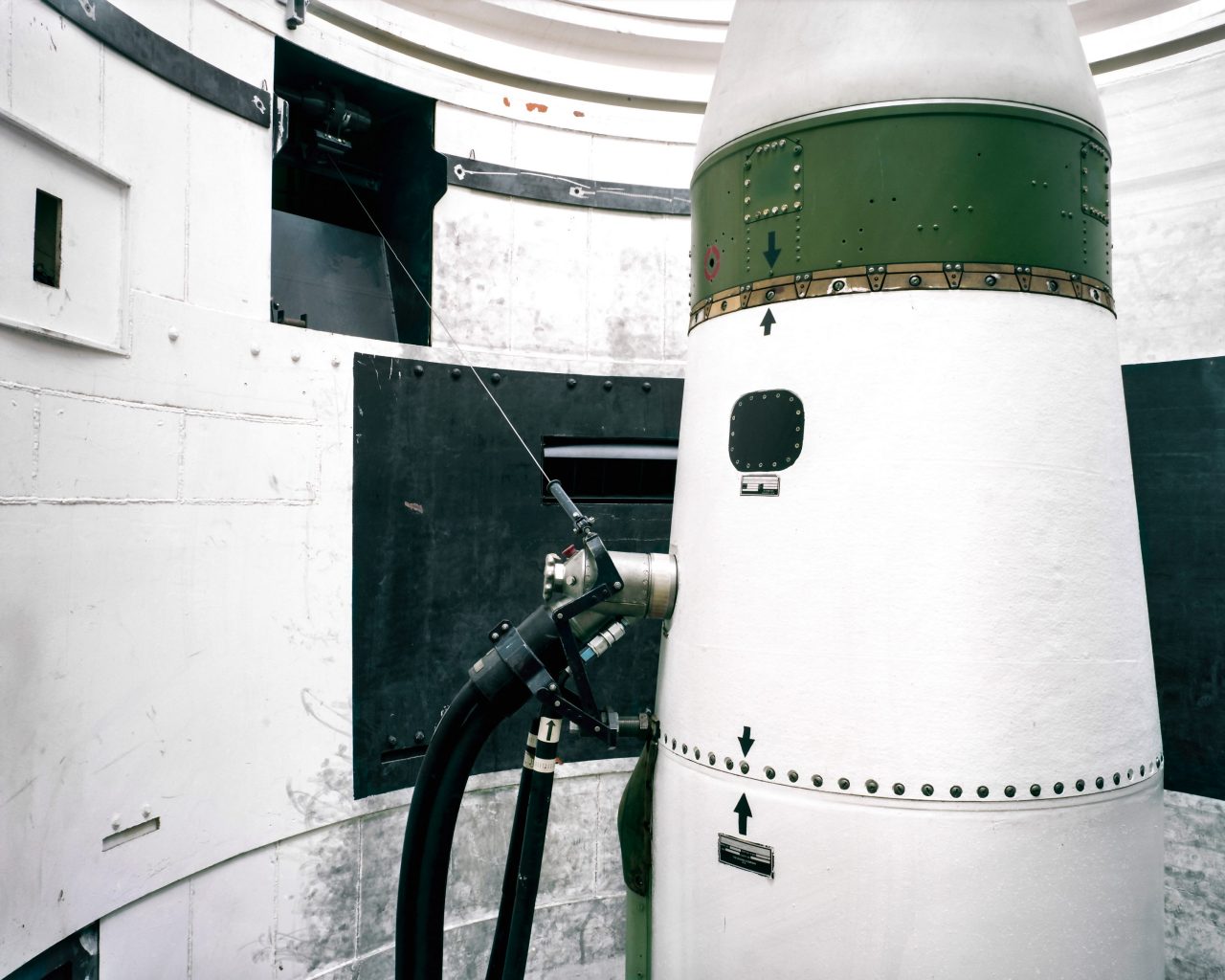Just War?
The idea that war is justified in specific circumstances has held sway for almost two millennia – but as technology evolves, can it hold?
Eight hundred-year-old theological deliberations don’t often make it into the opinion pages of The New York Times. But that’s what happened when Dr Daniel Weiss, Senior Lecturer in the Faculty of Divinity, found his analysis of St Thomas Aquinas’s stance on ‘just war’ invoked in the US debate on gun control. The Times op-ed’s author asserted that “Christianity…. insists on the protection of the innocent”, and cited a paper by Weiss that read: “Aquinas holds that causing the death of innocents in a foreseeable manner, whether intentionally or indirectly, is never justified.”

Surface of the underground Titan II launch facility at the Titan Missile Museum near Tucson, Arizona
“It was certainly a surprise,” says Weiss, who is also actively involved in the Cambridge Interfaith Programme. In response, a conservative publication, the National Review, took a different line. If Aquinas had held such a view, it argued, “it would mean that he had practically endorsed pacifism – since even a just war of self-defence entails foreseeably, although unintentionally, causing the death of innocents”. Weiss found the whole exchange fascinating. “There’s clearly a desire to have Aquinas as an authoritative source in relation to contemporary discussions of just war,” he says. “His work is still a touchstone.”
Gun control is only one of many contexts in which just war thinking is being re-examined. Technology such as drone warfare or facial recognition is blurring boundaries between supposedly passive surveillance and active aggression. And the growing visibility of social justice movements is prompting a greater willingness to re-examine the most fundamental concepts that a just war entails: what are the nation states that wage war? Whose bodies are those protected or eliminated?

Minuteman II training missile at Minuteman Missile National Historic Site, South Dakota.
The notion of ‘just war’ as understood today holds that conflict may be justifiable even though innocents will suffer as a consequence, if it is undertaken for morally sound reasons. Its roots stretch as far back as Old Testament scripture, such as the injunction in the Biblical book of Deuteronomy (20:19) that “when you besiege a city for a long time, while making war against it” you should not cut down its fruit trees, “for the tree of the field is man’s food”. But as Weiss notes, this is “not a formulation of what would make a war just or unjust. That’s a conversation for later Jewish rabbinic tradition, and the 4th and 5th-century Christian Church Fathers Ambrose and Augustine. Even in Augustine, the concept of just war is not fully fleshed out. It’s a gradual development.”
Dr Hazem Kandil, Reader in Political Sociology, points out that by the late 20th century, “modern governments seldom refer directly to the just war doctrine, due to its particular religious connotations”. Instead, secular equivalents abound. “The United States, for instance, has put forth several moral justifications for waging war since 1945. One prominent excuse is liberating the oppressed. In countries like Cuba and Vietnam, Iraq and Libya, the narrative is that people long for freedom, but are held down by dictators and their nefarious international allies.” A closely allied justification is humanitarian intervention in the face of genocide and crimes against humanity. “This principle was espoused in the 1990s, applied in the Balkans, and reinvented as ‘responsibility to protect’ by the United Nations,” says Kandil.

First-stage engine of a Titan II intercontinental ballistic missile as seen from Level 7 of the Titan II missile silo.
Other rationales for combat have a more Orwellian tinge, in which “war means peace”, Kandil proposes. In this framework, “an international community can only hope to live in harmony if rogue states are reined in. Military aggression must be reversed, as in the Gulf War of 1991. Sponsoring violence must be punished, as the Taliban learned after 9/11. Indeed, peacemakers ought to remain vigilant, pre-empting renegade regimes, such as the axis of evil running through Baghdad, Tehran and Pyongyang, before they can cause too much damage.”
And a third strand of thinking about just war is now dominant among governments worldwide – democracies as well as autocracies – argues Kandil. “It borrows from the legitimacy of domestic law enforcement. External warfare should be as routine as internal policing, and for the same reasons. Outlaws must be pursued and penalised.” This is the logic underlying the War on Terror, for example.

Suits used for propellant transfer hang outside the cableway tunnel leading to the Titan II missile silo.
But that legitimacy of domestic law enforcement is now increasingly under scrutiny. Dr Lauren Wilcox, Deputy Director of the University of Cambridge Centre for Gender Studies, notes how 20th-century theorists – such as Aimé Césaire, the poet and politician from Martinique who published his seminal Discourse on Colonialism in 1950 – have detailed the “blurred lines between colonial wars and domestic policing practices” in Europe and the US. More recent work, she says, has further detailed “the ways in which imperialist counterinsurgency strategies and domestic policing of racialised minorities intertwined and reinforced one another in the post-war years”.
For Wilcox, the very terms that historically have been used to frame debate on the justness or otherwise of war, require examination. “Feminist accounts question the terms by which ‘war’ and ‘peace’ are understood, precisely because of the exclusions of certain kinds of violence – such as sexual violence, structural violence and environmental violence – from our understanding of ‘peace’, as well as the ways in which these forms of violence stem from, and contribute to, more commonly understood forms of ‘war’.”

Day room Launch Control Facility Delta-01
The game of Battleship is set up in the day room of the Delta-01 Launch Control Facility at the Minuteman Missile National Historic Site in South Dakota.
Technology, too, is forcing re-examination of the way war – and its justness – is conceptualised. Weiss’s assertion that Aquinas could simultaneously endorse “just war while not permitting the killing of innocents” (an assertion that has provoked debate among Aquinas scholars, though not, he notes, any clear refutation) rests in part on the fact that contemporary military technology and practice, including armour that identified combatants and the use of target-specific weaponry such as lances, swords and pikes, enabled the avoidance of non-combatants.
The use of drones and similar remote technologies seem to offer the same get-out clause today. In Kandil’s work, for example, he has “come across moral justifications relating to how rather than why force is applied. If war can be waged in a way that produces minimum collateral damage and disruption to both aggressors and victims, then military power can be used with a clear conscience. Technology, of course, is the best hope for these humane warmongers.”

Command console and launch control equipment in the underground Launch Control Centre in the Titan II missile silo.
Reality, of course, is rather more complex. Rather than producing a limited, morally tidy form of warfare, these new technologies instead threaten to generate a state of perpetual war. Weiss recalls reading testimony from a Pakistani boy “who said that he now preferred cloudy rather than sunny days, as the drones don’t fly”. Kandil invokes the great war theorist, Carl von Clausewitz, to suggest that “charitable belligerents and their antiseptic campaigns can end up causing more harm. The delusion that war is controllable encourages them to embrace it much more readily than those resigned to the fact that war is destruction, pure and simple.”
According to Wilcox, who is currently completing a book manuscript titled War Beyond the Human: “The rise of ‘drones’ as prototypical instruments of post-human warfare corresponds to a growing sense that many countries are experiencing a perpetual condition of war – one which exceeds the temporal and spatial boundaries of war as it is usually conceived.” But she questions how new this phenomenon really is. “‘Permanent’ or ‘unending’ war without clear victory is not only a problem in a post-9/11 world of global surveillance, drone strikes, counterinsurgencies and such. Histories of colonial warfare reveal much continuity, particularly where air power is concerned.”

Blast door that seals the two-person crew inside the underground Launch Control Center in South Dakota.
Moreover, she says, just as the use of technology and AI algorithmic decision-making complicates the idea of the subject or enactor of war being human, the objects – the targets or recipients – of its violence equally “have been considered to be other than fully human”. Wilcox points out that feminist, queer, anti-racist and Black Studies scholars, question who the ‘human’ is in the posthuman, and note that, all too frequently, human is limited to the Western and masculine.
These questions exist at the forefront of theoretical thinking, even reaching as far as the Vatican. In October 2020, Pope Francis authored an encyclical letter that was widely interpreted as signalling a shift away from traditional ecclesiastical just war theory. In it, the Pope wrote that new forms of weaponry “have granted war an uncontrollable, destructive power over great numbers of innocent civilians”. Consequently, “it is very difficult nowadays to invoke the rational criteria elaborated in earlier centuries to speak of the possibility of a just war”. Particular interest focused on a footnote explicitly referencing Augustine, as one who “forged a concept of ‘just war’ that we no longer uphold in our own day”.

Row of telephones in the Security Control Centre at the Minuteman II Launch Control Facility Delta-01, South Dakota.
It remains to be seen whether Pope Francis will pursue this line further and distance the church entirely from the concept of just war. However, it is perhaps questionable how much impact it would have even if he did, for as Kandil notes: “War creates its own momentum, thwarting doctrinal musings articulated in peacetime. Soldiers say no plan survives first contact with the enemy. Similarly, war doctrines rarely outlast the realities of war.”
No Lone Zone
In this series, documentary photographer Adam Reynolds explores America’s Cold War-era nuclear arsenal, most of which is deactivated and dismantled today. A handful of these frozen time capsules are open to the public, catering to an array of nostalgic ‘nuclear tourists’, and serve as shrines to an Armageddon, preserving the dramatic vestiges of a power that can destroy the world. The sites stand sentinel as potent reminders of military might, but also serve as a cautionary tale for future generations.







